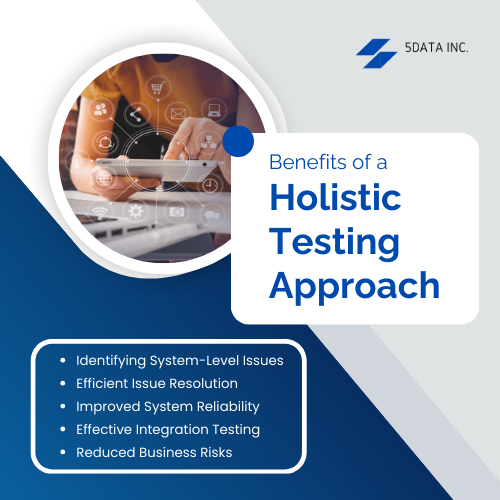What we cover in this blog
- Performance Testing: Ensuring Reliable Systems
- Holistic Testing: A Comprehensive Quality Approach
- Testing Integration in Software Development
- Automated Testing for Streamlined Processes
- Test Environment: Creating Realistic Scenarios
- Quality Software: The Ultimate Goal
- Early Issue Identification by Development Teams
- Benefits of a Holistic Testing Approach
Performance Testing: Ensuring Reliable Systems
The performance testing process assesses how a software system performs under different conditions, including evaluating response time, reliability, and scalability. Response time is a key metric that directly impacts user experience. To achieve this, teams conduct many tests such as load testing, scalability testing, stress testing, and many more to identify potential bottlenecks and areas for betterment.Holistic Testing: A Comprehensive Quality Approach
Holistic testing is an approach to software testing that considers the entire system as a unified entity rather than focusing on individual components or features in isolation. The term “holistic” implies a comprehensive and interconnected perspective, where the goal is to assess how different parts of the system work together to achieve the desired outcome. Holistic testing is particularly valuable in complex software systems where the behavior of one component can impact others. By adopting this approach, development and testing teams can uncover issues related to system integration, data flow, and overall system performance that might not be apparent when testing individual features in isolation. A Top Application Development Company prioritizes step-by-step holistic testing techniques to ensure the production of quality software.Testing Integration in Software Development
A successful testing process is integrated into the entire software development lifecycle. Early stages of testing, conducted in parallel with development, help identify and address issues before they become ingrained in the system. Continuous feedback loops between development and testing teams facilitate agile adjustments, enhancing the overall quality of the software.Automated Testing for Streamlined Processes
Automation plays a crucial role in the modern software testing process. Automated tests not only expedite the testing process but also ensure reliability and consistency. Continuous testing, enabled by automated testing tools, allows teams to receive prompt feedback on new features and changes, reducing the risks of introducing bugs into the system.Test Environment: Creating Realistic Scenarios
A realistic test environment plays an important role in accurate testing. Teams must replicate the production environment as closely as possible to identify potential performance issues that may occur in real-world usage, including simulating different user scenarios, network conditions, and loads to ensure the software performs optimally under diverse conditions.Quality Software: The Ultimate Goal
Finally, the goal of software testing is the production of high-quality products. Quality software is characterized by reliability, responsiveness, and the capability to meet or exceed customers’ expectations. Testing, particularly performance and holistic testing, plays an important role in achieving and maintaining these quality attributes throughout the development process. One of the Best software application development services includes software security, cloud computing, custom software development, and more to ensure the production of quality software products.Early Issue Identification by Development Teams
Incorporating testing techniques into the development process empowers development teams to identify and address issues at early stages. This proactive approach not only reduces the cost of fixing bugs but also ensures that the software meets performance and quality standards from the outset.
Benefits of a Holistic Testing Approach
Embracing a holistic testing approach, including performance testing, brings several benefits. It allows teams to find problems early, mitigating risks associated with software development. By identifying issues in the early stages, development teams can allocate resources more efficiently, reducing costs and ensuring a smoother production stage. Such benefits are:
- Identifying System-Level Issues: Holistic testing helps uncover issues that may arise from the interactions between different components of the system, including problems related to data flow, communication between modules, and overall system integration.
- Efficient Issue Resolution: Holistic testing enables the identification of issues early in the development process, reducing the likelihood of bugs becoming deeply ingrained in the system. This proactive approach to issue resolution helps save time and resources.
- Improved System Reliability: By assessing the system as a whole, holistic testing contributes to the identification and resolution of potential reliability issues, ensuring that the software operates consistently and reliably across various scenarios.
- Effective Integration Testing: Integration testing, which is a key component of holistic testing, helps identify problems that may arise when individual components are integrated into the complete system, ensuring that all parts of the software work seamlessly together.
- Reduced Business Risks: By identifying and resolving issues early in the development process, holistic testing contributes to reducing the business risks associated with software development, including risks related to project delays, budget overruns, and user dissatisfaction.
A Software Application Development Company can follow a holistic testing approach to solve key problems of classical development, such as dependencies, management, and inconsistencies, to improve system reliability, reduce business risks, identify system-level issues, and other critical components for efficient testing.
Conclusion
In the ever-evolving landscape of software development, a holistic approach to testing, encompassing performance testing and continuous testing, is imperative. It enables teams to deliver high-quality software that not only meets user expectations but also performs optimally under diverse conditions. As software continues to assume an ever more pivotal role in various industries, the importance of a robust testing strategy cannot be overstated. By incorporating testing throughout the development process, teams can identify, address, and prevent issues, ultimately delivering software that stands the test of performance and quality.

About the Author...
Amulya Sukrutha is a passionate computer science engineer specializing in the Data science field. She also describes herself as an enthusiastic strength and endurance trainee. She played professional tennis during her early years and found her path in Software development and machine learning later. She is also passionate about creating content and learning about new technologies.
